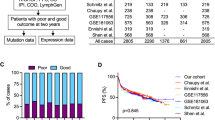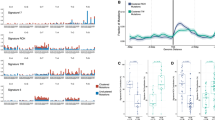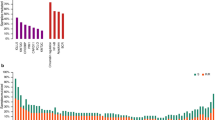Abstract
High-grade B-cell lymphoma, not otherwise specified (HGBL-NOS) is rare and data focused on these neoplasms is lacking. We studied the clinicopathologic and genetic features of 136 HGBL-NOS patients and compared them to patients with DLBCL/HGBL-DH (n = 224, defined by 5th Edition WHO) and DLBCL (n = 217). HGBL-NOS patients had clinical features similar to DLBCL/HGBL-DH patients. MYC rearrangement (MYC-R) was present in 43% of HGBL-NOS. With induction regimen similar to DLBCL/HGBL-DH patients, HGBL-NOS patients had a median overall survival (OS) of 28.9 months, similar to DLBCL/HGBL-DH (p = 0.48) but inferior to DLBCL patients (p = 0.03). R-EPOCH induction was associated with improved OS compared with R-CHOP. MYC-R, history of lymphoma, and high IPI were independent adverse prognostic factors in HGBL-NOS patients. Whole transcriptome profiling performed on a subset of HGBL-NOS cases showed a profile more similar to DLBCL/HGBL-DH than to DLBCL; 53% of HGBL-NOS had a DH-like signature (DH-like-Sig) and were enriched for MYC-R. DH-like-Sig+ HGBL-NOS patients had a poorer OS than DH-like-Sig-negative patients (p = 0.04). In conclusion, HGBL-NOS has clinicopathologic features and a gene expression profile more similar to DLBCL/HGBL-DH than to DLBCL. Cases of HGBL-NOS frequently carry MYC-R and have a DH-like-Sig+. R-EPOCH induction in HGBL-NOS appears associated with improved OS compared with standard R-CHOP.
This is a preview of subscription content, access via your institution
Access options
Subscribe to this journal
Receive 12 print issues and online access
$259.00 per year
only $21.58 per issue
Buy this article
- Purchase on Springer Link
- Instant access to full article PDF
Prices may be subject to local taxes which are calculated during checkout







Similar content being viewed by others
Data availability
The datasets of the current study are available from the corresponding author on reasonable request.
Change history
23 January 2023
The name L. Jeffrey Medeiros has been tagged correctly.
References
Medeiros LJ, O’Malley D, Caraway NC, Vega F, Elenitoba-Johnson KSJ, Lim MS. Tumors of the Lymph Nodes and Spleen. American Registry of Pathology; 2017.
Swerdlow SH. Diagnosis of ‘double hit’ diffuse large B-cell lymphoma and B-cell lymphoma, unclassifiable, with features intermediate between DLBCL and Burkitt lymphoma: when and how, FISH versus IHC. Hematol Am Soc Hematol Educ Program. 2014;2014:90–9.
Harris NL, Jaffe ES, Stein H, Banks PM, Chan JK, Cleary ML, et al. A revised European-American classification of lymphoid neoplasms: a proposal from the International Lymphoma Study Group. Blood. 1994;84:1361–92.
Kluin PM HN, Stein H, Leoncini L, Raphael M, Campo E, Jaffe ES. B-cell lymphoma, unclassifiable, with features intermediate between diffuse large B-cell lymphoma and Burkitt lymphoma. In: Swerdlow SH, Campo, E., Harris, N.L., Jaffe, E.S., Pileri, S.A., Stein, H., Thiele, J., Vardiman, J.W, editors. WHO Classification of Tumours of Haematopoietic and Lymphoid Tissues. 4th ed. Lyon: IARC; 2008. p. 265–7.
Kluin PM, Campo E, Harris NL, Jaffe ES, Stein H, Gascoyne RD, et al. High Grade B-Cell Lymphoma. In: Swerdlow EH CE, Harris NL, Jaffe ES, et al., editors. WHO Classification of Tumours of Haematopoietic and Lymphoid Tissues. Revised 4th Edition ed. Lyon, France: IARC; 2017.
Alaggio R, Amador C, Anagnostopoulos I, Attygalle AD, Araujo IBO, Berti E, et al. The 5th edition of the World Health Organization Classification of Haematolymphoid Tumours: Lymphoid Neoplasms. Leukemia. 2022;36:1720–48.
Aukema SM, Kreuz M, Kohler CW, Rosolowski M, Hasenclever D, Hummel M, et al. Biological characterization of adult MYC-translocation-positive mature B-cell lymphomas other than molecular Burkitt lymphoma. Haematologica. 2014;99:726–35.
Li S, Lin P, Fayad LE, Lennon PA, Miranda RN, Yin CC, et al. B-cell lymphomas with MYC/8q24 rearrangements and IGH@BCL2/t(14;18)(q32;q21): an aggressive disease with heterogeneous histology, germinal center B-cell immunophenotype and poor outcome. Mod Pathol. 2012;25:145–56.
Li S, Lin P, Medeiros LJ. Advances in pathological understanding of high-grade B cell lymphomas. Expert Rev Hematol. 2018;11:637–48.
Li S, Saksena A, Desai P, Xu J, Zuo Z, Lin P, et al. Prognostic impact of history of follicular lymphoma, induction regimen and stem cell transplant in patients with MYC/BCL2 double hit lymphoma. Oncotarget. 2016;7:38122–32.
Oki Y, Noorani M, Lin P, Davis RE, Neelapu SS, Ma L, et al. Double hit lymphoma: the MD Anderson Cancer Center clinical experience. Br J Haematol. 2014;166:891–901.
Petrich AM, Gandhi M, Jovanovic B, Castillo JJ, Rajguru S, Yang DT, et al. Impact of induction regimen and stem cell transplantation on outcomes in double-hit lymphoma: a multicenter retrospective analysis. Blood. 2014;124:2354–61.
Lin P, Medeiros LJ. High-grade B-cell lymphoma/leukemia associated with t(14;18) and 8q24/MYC rearrangement: a neoplasm of germinal center immunophenotype with poor prognosis. Haematologica. 2007;92:1297–301.
Landsburg DJ, Falkiewicz MK, Maly J, Blum KA, Howlett C, Feldman T, et al. Outcomes of Patients With Double-Hit Lymphoma Who Achieve First Complete Remission. J Clin Oncol. 2017;35:2260–7.
Ennishi D, Jiang A, Boyle M, Collinge B, Grande BM, Ben-Neriah S, et al. Double-Hit Gene Expression Signature Defines a Distinct Subgroup of Germinal Center B-Cell-Like Diffuse Large B-Cell Lymphoma. J Clin Oncol. 2019;37:190–201.
Khanlari M, Medeiros LJ, Lin P, Xu J, You MJ, Tang G, et al. Blastoid high-grade B-cell lymphoma initially presenting in bone marrow: a diagnostic challenge. Mod Pathol. 2022;35:419–26.
Huang W, Medeiros LJ, Lin P, Wang W, Tang G, Khoury J, et al. MYC/BCL2/BCL6 triple hit lymphoma: a study of 40 patients with a comparison to MYC/BCL2 and MYC/BCL6 double hit lymphomas. Mod Pathol. 2018;31:1470–8.
Wang L, Tang G, Medeiros JL, Xu J, Huang W, Yin CC, et al. MYC rearrangement but not extra MYC copies is an independent prognostic factor in patients with mantle cell lymphoma. Haematologica. 2021;106:1381–9.
Hans CP, Weisenburger DD, Greiner TC, Gascoyne RD, Delabie J, Ott G, et al. Confirmation of the molecular classification of diffuse large B-cell lymphoma by immunohistochemistry using a tissue microarray. Blood. 2004;103:275–82.
Green TM, Young KH, Visco C, Xu-Monette ZY, Orazi A, Go RS, et al. Immunohistochemical double-hit score is a strong predictor of outcome in patients with diffuse large B-cell lymphoma treated with rituximab plus cyclophosphamide, Doxorubicin, vincristine, and prednisone. J Clin Oncol. 2012;30:3460–7.
Johnson NA, Slack GW, Savage KJ, Connors JM, Ben-Neriah S, Rogic S, et al. Concurrent Expression of MYC and BCL2 in Diffuse Large B-Cell Lymphoma Treated With Rituximab Plus Cyclophosphamide, Doxorubicin, Vincristine, and Prednisone. J Clin Oncol. 2012;30:3452–9.
Li S, Seegmiller AC, Lin P, Wang XJ, Miranda RN, Bhagavathi S, et al. B-cell lymphomas with concurrent MYC and BCL2 abnormalities other than translocations behave similarly to MYC/BCL2 double-hit lymphomas. Mod Pathol. 2015;28:208–17.
Quesada AE, Medeiros LJ, Desai PA, Lin P, Westin JR, Hawsawi HM, et al. Increased MYC copy number is an independent prognostic factor in patients with diffuse large B-cell lymphoma. Mod Pathol. 2017;30:1688–97.
Ziepert M, Lazzi S, Santi R, Vergoni F, Granai M, Mancini V, et al. A 70% cut-off for MYC protein expression in diffuse large B cell lymphoma identifies a high-risk group of patients. Haematologica. 2020;105:2667–70.
McGowan-Jordan J, Schmid M, GmbH SK. ISCN 2016 An International System for Human Cytogenomic Nomenclature (2016). Reprint of: Cytogenetic and Genome Research 2016;149, No. 1-2.
Qi Z, Wang L, Desai K, Cogswell J, Stern M, Lawson B, et al. Reliable Gene Expression Profiling from Small and Hematoxylin and Eosin-Stained Clinical Formalin-Fixed, Paraffin-Embedded Specimens Using the HTG EdgeSeq Platform. J Mol Diagn. 2019;21:796–807.
Godoy PM, Barczak AJ, DeHoff P, Srinivasan S, Etheridge A, Galas D, et al. Comparison of Reproducibility, Accuracy, Sensitivity, and Specificity of miRNA Quantification Platforms. Cell Rep. 2019;29:4212–22 e4215.
Zhang L, Cham J, Cooley J, He T, Hagihara K, Yang H, et al. Cross-platform comparison of immune-related gene expression to assess intratumor immune responses following cancer immunotherapy. J Immunol Methods. 2021;494:113041.
Campo E, Jaffe ES, Cook JR, Quintanilla-Martinez L, Swerdlow SH, Anderson KC, et al. The International Consensus Classification of Mature Lymphoid Neoplasms: a report from the Clinical Advisory Committee. Blood. 2022;140:1229–53.
Ok CY, Medeiros LJ, Thakral B, Tang G, Jain N, Jabbour E, et al. High-grade B-cell lymphomas with TdT expression: a diagnostic and classification dilemma. Mod Pathol. 2019;32:48–58.
Bhavsar S, Liu YC, Gibson SE, Moore EM, Swerdlow SH. Mutational Landscape of TdT+ Large B-cell Lymphomas Supports Their Distinction From B-lymphoblastic Neoplasms: A Multiparameter Study of a Rare and Aggressive Entity. Am J Surg Pathol. 2022;46:71–82.
Li J, Liu X, Yao Z, Zhang M. High-Grade B-Cell Lymphomas, Not Otherwise Specified: A Study of 41 Cases. Cancer Manag Res. 2020;12:1903–12.
Moharana L, Dasappa L, Babu S, Lokesh KN, Rudresh A, Rajeev LK, et al. Comparison Between CHOP and DAEPOCH with or Without Rituximab in Adult High Grade B Cell Lymphoma, Not Otherwise Specified; A Retrospective Study From a Tertiary Cancer Hospital in South India. Indian J Hematol Blood Transfus. 2022;38:15–23.
Olszewski A, Kurt H, Evens AM. Defining and Treating High-grade B-cell lymphoma, NOS. Blood. 2022;140:943–54.
Zayac A, Landsburg D, Hughes M, Ayers E, Girton M, Hu M, et al. High-Grade B-Cell Lymphoma, Not Otherwise Specified (HGBL, NOS): Characteristics, Treatment, and Outcomes from 17 Academic US Centers. Blood. 2021;138:455–8.
Gonzalez de Villambrosia S, Bastos M, Palanca JM, Cruz JG, Navarro JT, Tapia G, et al. BCL2 translocation in high grade B cell lymphoma (NOS, DH/TH) is associated with reduced progression free survival. Leuk Lymphoma. 2022;63:101–8.
Collinge BJHL, Wong J, Ben-Neriah S, Rushton CK, Slack GW, Farinha P, et al. Characterization of the genetic landscape of high-grade B-cell lymphoma, nos – an llmpp project. Hematological Oncol. 2021;39:157–9.
Sha C, Barrans S, Cucco F, Bentley MA, Care MA, Cummin T, et al. Molecular High-Grade B-Cell Lymphoma: Defining a Poor-Risk Group That Requires Different Approaches to Therapy. J Clin Oncol. 2019;37:202–12.
Hilton LK, Tang J, Ben-Neriah S, Alcaide M, Jiang A, Grande BM, et al. The double-hit signature identifies double-hit diffuse large B-cell lymphoma with genetic events cryptic to FISH. Blood. 2019;134:1528–32.
Evrard SM, Pericart S, Grand D, Amara N, Escudie F, Gilhodes J, et al. Targeted next generation sequencing reveals high mutation frequency of CREBBP, BCL2 and KMT2D in high-grade B-cell lymphoma with MYC and BCL2 and/or BCL6 rearrangements. Haematologica. 2019;104:e154–e157.
Kunstner A, Witte HM, Riedl J, Bernard V, Stolting S, Merz H, et al. Mutational landscape of high-grade B-cell lymphoma with MYC-, BCL2 and/or BCL6 rearrangements characterized by whole-exome sequencing. Haematologica. 2022;107:1850–63.
Stengel A, Kern W, Meggendorfer M, Haferlach T, Haferlach C. Detailed molecular analysis and evaluation of prognosis in cases with high grade B-cell lymphoma with MYC and BCL2 and/or BCL6 rearrangements. Br J Haematol. 2019;185:951–4.
Acknowledgements
The study was partially supported by Faculty Startup Fund (SL) and Research Grant (LQ and SL) from the Division of Pathology and Laboratory Medicine, The University of Texas MD Anderson Cancer Center.
Author information
Authors and Affiliations
Contributions
SL designed the study, collected data, analyzed data, and wrote the paper; LQ collected data, analyzed data, and wrote the paper; JX, PL, CYO, GT, TJM, MJY, MK, and RNM contributed data and edited the paper; LJM contributed data, analyzed data and wrote the paper. All authors edited and approved the final version of the paper.
Corresponding author
Ethics declarations
Competing interests
The authors have disclosed that they have no relationships with, or financial interest in, any commercial companies pertaining to this paper.
Additional information
Publisher’s note Springer Nature remains neutral with regard to jurisdictional claims in published maps and institutional affiliations.
Supplementary information
Rights and permissions
Springer Nature or its licensor (e.g. a society or other partner) holds exclusive rights to this article under a publishing agreement with the author(s) or other rightsholder(s); author self-archiving of the accepted manuscript version of this article is solely governed by the terms of such publishing agreement and applicable law.
About this article
Cite this article
Li, S., Qiu, L., Xu, J. et al. High-grade B-cell lymphoma (HGBL)-NOS is clinicopathologically and genetically more similar to DLBCL/HGBL-DH than DLBCL. Leukemia 37, 422–432 (2023). https://doi.org/10.1038/s41375-022-01778-9
Received:
Revised:
Accepted:
Published:
Issue Date:
DOI: https://doi.org/10.1038/s41375-022-01778-9



